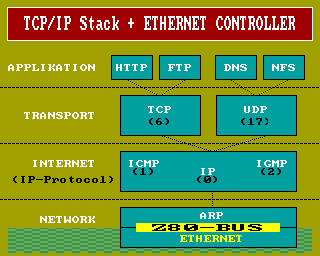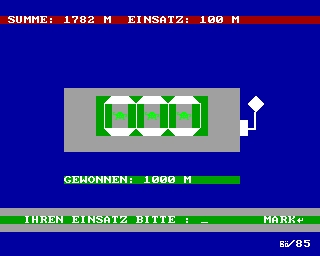Ethernet Controller
The second possible solution is, so far not seen with a Z80 system, to take a suitable Ethernet-Controller and connect it with the bus of your system. This works like a PC network-card and allows direct access to a Ethernet network. The following picture illustrates this.
The software TCP/IP-stack sits on top of the hardware interface, which must be programmed from a driver for memory-mapped I/O or direct I/O. This depends on the elected Ethernet-controller.

The "RR-Net" for the C64 is one example from the year 2003.
2003: RR-Net - 10 MBit Ethernet Network-Card for C64
- Jens Schönfeld
- http://www.jschoenfeld.com/news/news88_e.htm
- http://www.c64web.com
- Clock-Port
- memory-mapped I/O
- 6510 Assembler
So far, not many software exists for this card. I cannot judge exactly this solution, but the second link above shows the "real thing" : a "contiki" based web server on a C64. By substituting the slow RS-232 interface with a fast Ethernet controller, a disadvantage is removed, all other circumstances remain similar as with PPP / SLIP.
freely programmable - very good memory usage - extremely high system load through the stack - high stability and reliability - depends on memory usage other computer or server needed - no system load through network activity - can become high transfer speed of network data - bad response time and usability - bad communication capabilities - very good implementation of standard RFC-protocols - depends on memory usage convenient API for network programming - depends on memory usage compatibility with other Z80 systems - depends on hardware interface login / authentification / connection - no
One must build a hardware-interface for the system, that would not really be an obstacle. But the high memory requirement for a software stack with network application, and the burden of the entire system through the stack itself are reasons to drop this way. If new hardware is required, there are other solutions.
Further problems can occur with this solution as well. The software stack must process all Ethernet-packets of the network, in order to find out whether they are intended for it. With high broadcast's traffic, this leads to a heavy system load and response time, and usability can decrease drastically!

